Analysis of Bandura's Social Cognitive Theory with Tesco Case Study
VerifiedAdded on 2023/01/04
|11
|2043
|28
Essay
AI Summary
This essay delves into Albert Bandura's Social Cognitive Theory, emphasizing self-efficacy and its application to a Tesco case study. The introduction outlines Bandura's departure from traditional learning theories, highlighting the role of observation, imitation, and modeling. The analysis section defines self-efficacy and examines its impact on employee performance within Tesco, particularly focusing on Dave Lewis's leadership and its influence on the company's cost-cutting measures. The essay explores the four sources of self-efficacy: performance outcomes, vicarious experiences, verbal persuasion, and physiological feedback, relating each to the Tesco scenario. Bandura's Triadic Reciprocal Determinism, comprising personal, behavioral, and environmental factors, is applied to understand the case. The conclusion summarizes the theory, emphasizing how Jana, a manager, can address low self-efficacy issues within the store by focusing on performance outcomes, vicarious experiences, verbal persuasion, and physiological feedback. The essay emphasizes the interconnectedness of these factors in shaping individual and organizational outcomes. References to key academic sources are provided.
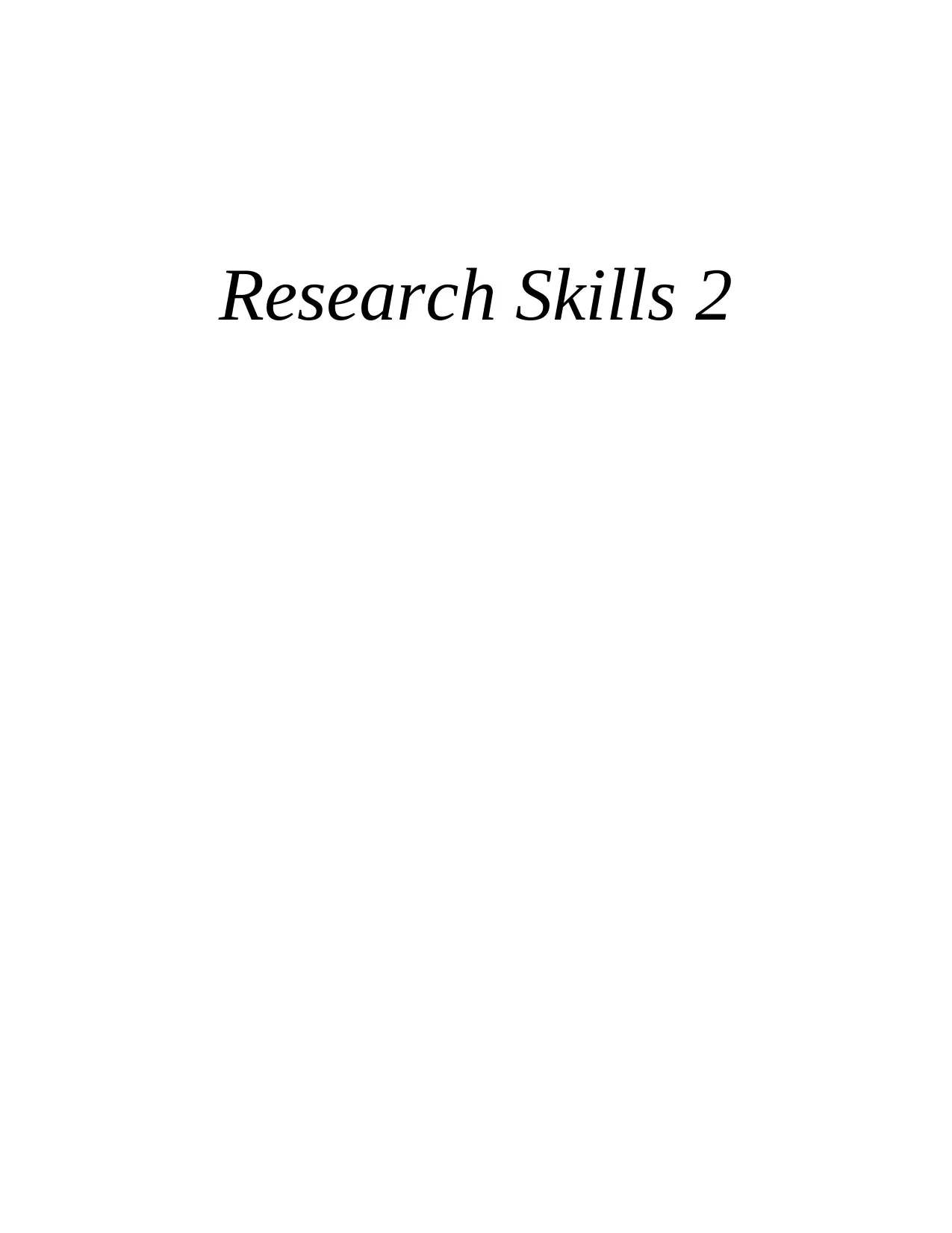
Research Skills 2
Paraphrase This Document
Need a fresh take? Get an instant paraphrase of this document with our AI Paraphraser
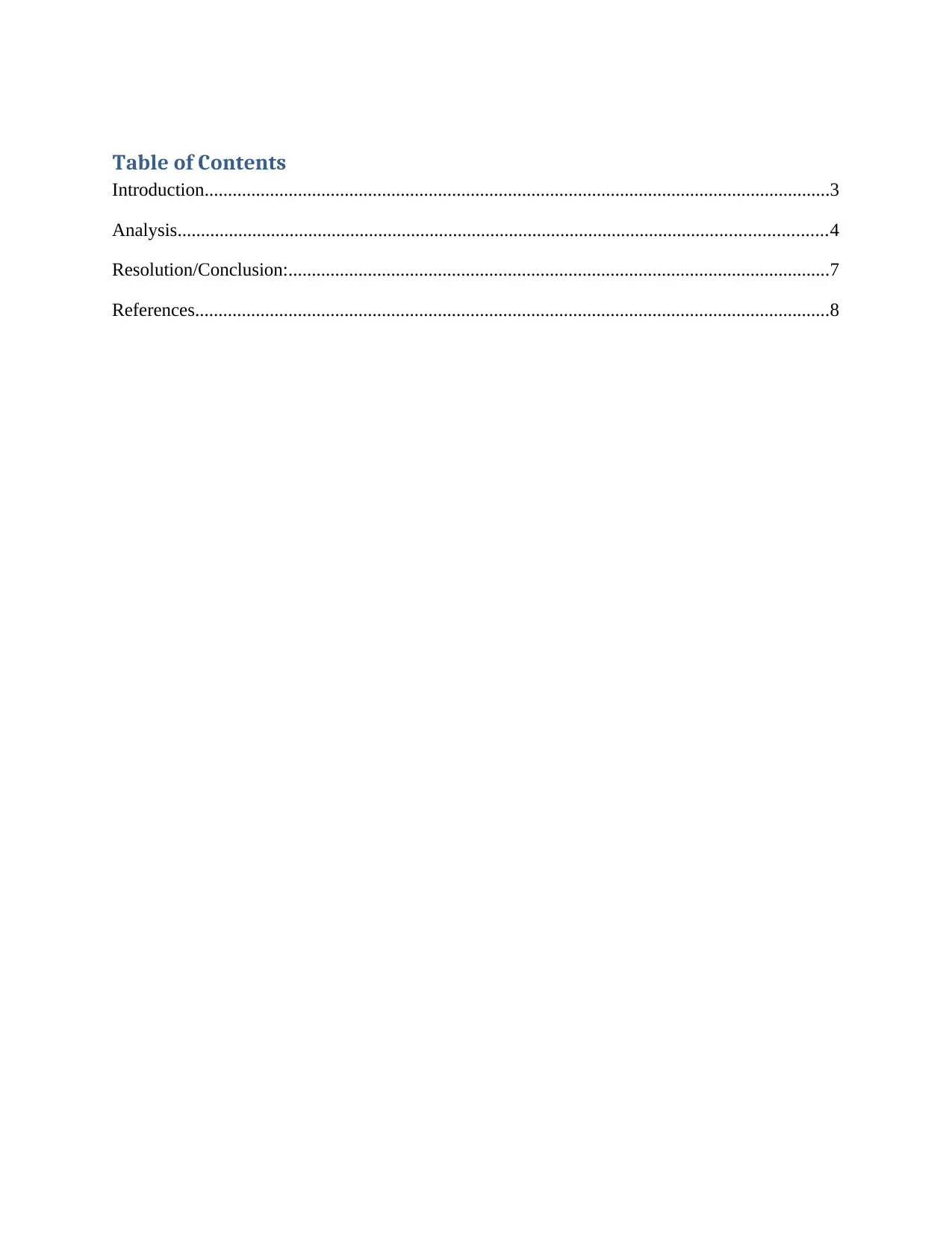
Table of Contents
Introduction......................................................................................................................................3
Analysis...........................................................................................................................................4
Resolution/Conclusion:....................................................................................................................7
References........................................................................................................................................8
Introduction......................................................................................................................................3
Analysis...........................................................................................................................................4
Resolution/Conclusion:....................................................................................................................7
References........................................................................................................................................8
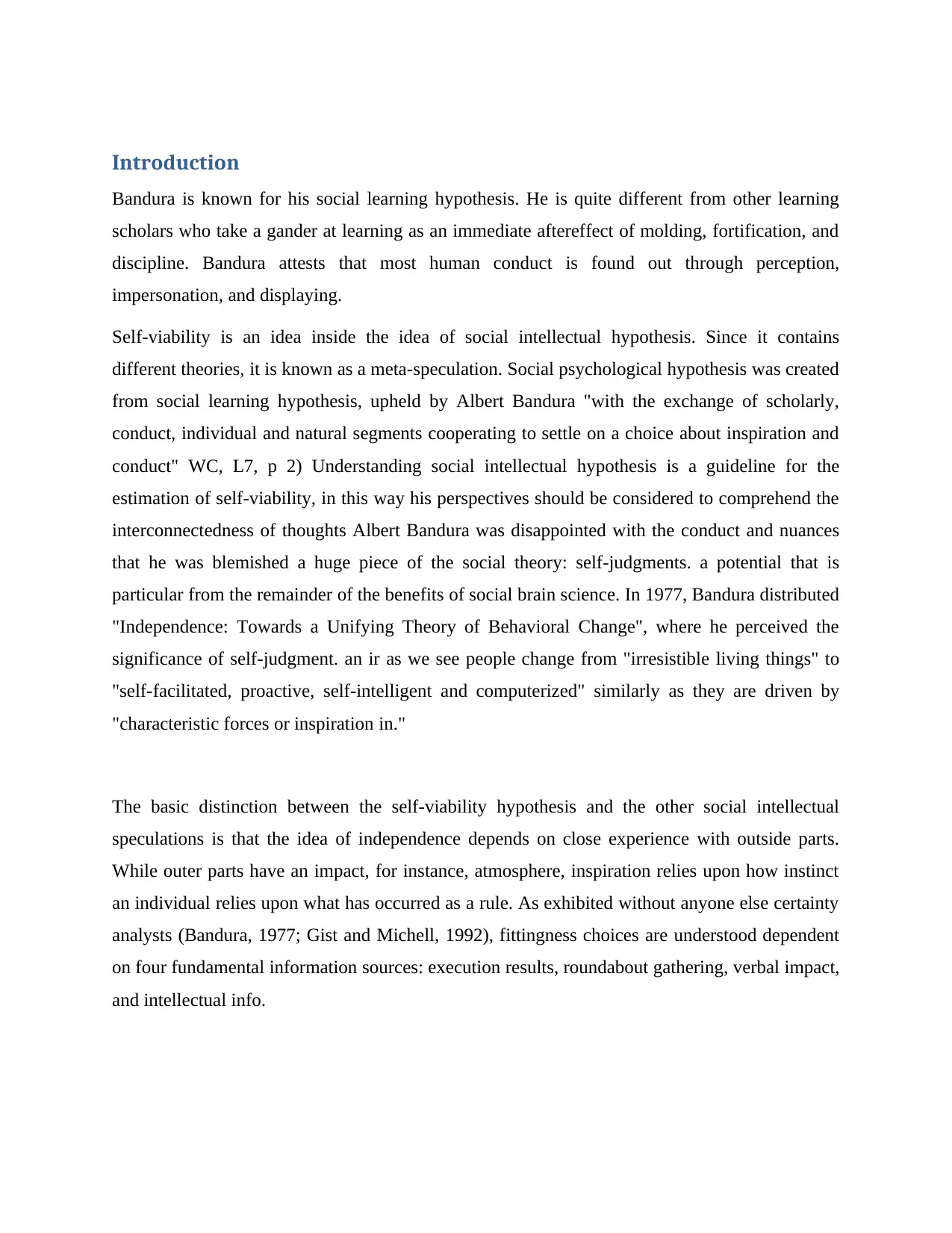
Introduction
Bandura is known for his social learning hypothesis. He is quite different from other learning
scholars who take a gander at learning as an immediate aftereffect of molding, fortification, and
discipline. Bandura attests that most human conduct is found out through perception,
impersonation, and displaying.
Self-viability is an idea inside the idea of social intellectual hypothesis. Since it contains
different theories, it is known as a meta-speculation. Social psychological hypothesis was created
from social learning hypothesis, upheld by Albert Bandura "with the exchange of scholarly,
conduct, individual and natural segments cooperating to settle on a choice about inspiration and
conduct" WC, L7, p 2) Understanding social intellectual hypothesis is a guideline for the
estimation of self-viability, in this way his perspectives should be considered to comprehend the
interconnectedness of thoughts Albert Bandura was disappointed with the conduct and nuances
that he was blemished a huge piece of the social theory: self-judgments. a potential that is
particular from the remainder of the benefits of social brain science. In 1977, Bandura distributed
"Independence: Towards a Unifying Theory of Behavioral Change", where he perceived the
significance of self-judgment. an ir as we see people change from "irresistible living things" to
"self-facilitated, proactive, self-intelligent and computerized" similarly as they are driven by
"characteristic forces or inspiration in."
The basic distinction between the self-viability hypothesis and the other social intellectual
speculations is that the idea of independence depends on close experience with outside parts.
While outer parts have an impact, for instance, atmosphere, inspiration relies upon how instinct
an individual relies upon what has occurred as a rule. As exhibited without anyone else certainty
analysts (Bandura, 1977; Gist and Michell, 1992), fittingness choices are understood dependent
on four fundamental information sources: execution results, roundabout gathering, verbal impact,
and intellectual info.
Bandura is known for his social learning hypothesis. He is quite different from other learning
scholars who take a gander at learning as an immediate aftereffect of molding, fortification, and
discipline. Bandura attests that most human conduct is found out through perception,
impersonation, and displaying.
Self-viability is an idea inside the idea of social intellectual hypothesis. Since it contains
different theories, it is known as a meta-speculation. Social psychological hypothesis was created
from social learning hypothesis, upheld by Albert Bandura "with the exchange of scholarly,
conduct, individual and natural segments cooperating to settle on a choice about inspiration and
conduct" WC, L7, p 2) Understanding social intellectual hypothesis is a guideline for the
estimation of self-viability, in this way his perspectives should be considered to comprehend the
interconnectedness of thoughts Albert Bandura was disappointed with the conduct and nuances
that he was blemished a huge piece of the social theory: self-judgments. a potential that is
particular from the remainder of the benefits of social brain science. In 1977, Bandura distributed
"Independence: Towards a Unifying Theory of Behavioral Change", where he perceived the
significance of self-judgment. an ir as we see people change from "irresistible living things" to
"self-facilitated, proactive, self-intelligent and computerized" similarly as they are driven by
"characteristic forces or inspiration in."
The basic distinction between the self-viability hypothesis and the other social intellectual
speculations is that the idea of independence depends on close experience with outside parts.
While outer parts have an impact, for instance, atmosphere, inspiration relies upon how instinct
an individual relies upon what has occurred as a rule. As exhibited without anyone else certainty
analysts (Bandura, 1977; Gist and Michell, 1992), fittingness choices are understood dependent
on four fundamental information sources: execution results, roundabout gathering, verbal impact,
and intellectual info.
⊘ This is a preview!⊘
Do you want full access?
Subscribe today to unlock all pages.

Trusted by 1+ million students worldwide
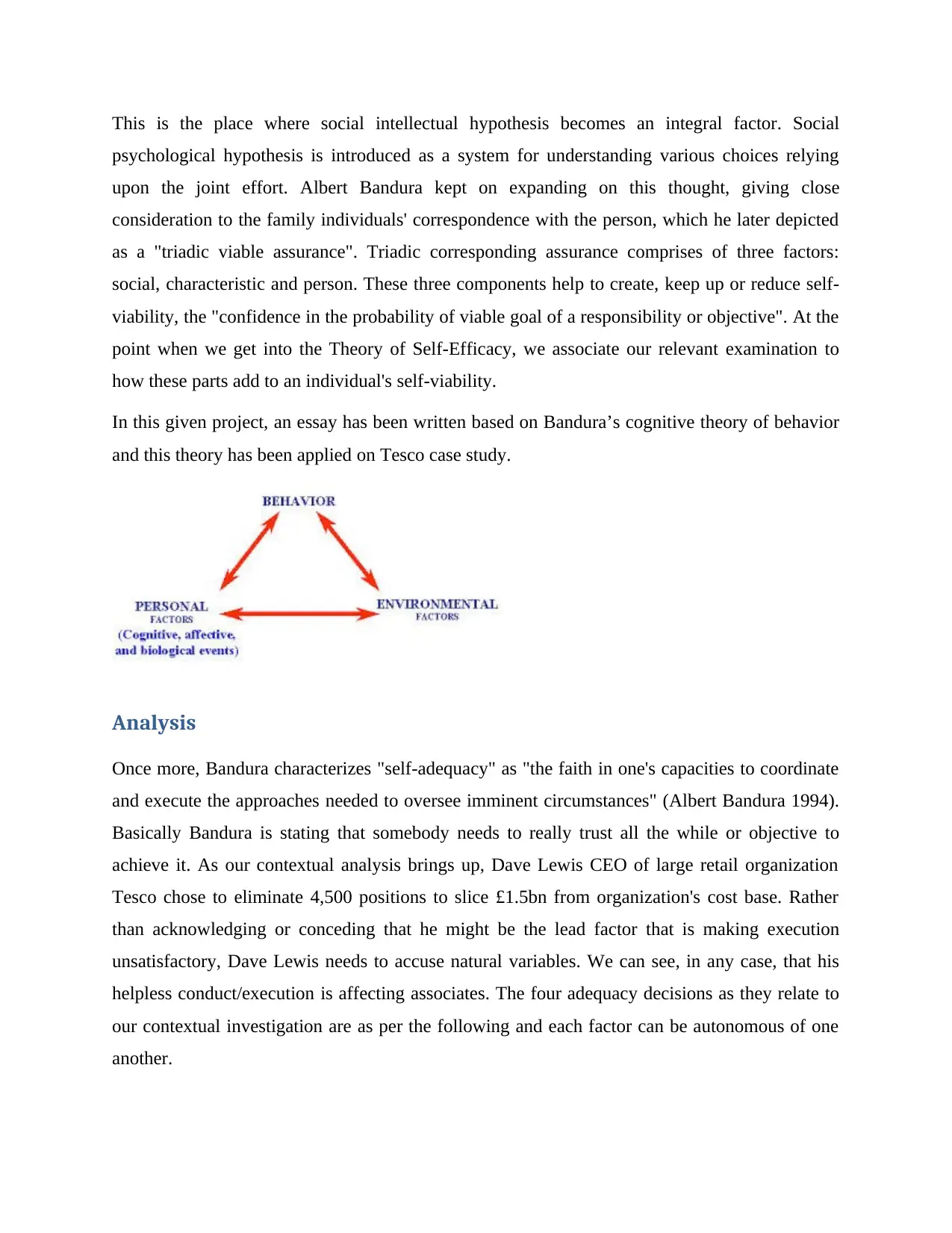
This is the place where social intellectual hypothesis becomes an integral factor. Social
psychological hypothesis is introduced as a system for understanding various choices relying
upon the joint effort. Albert Bandura kept on expanding on this thought, giving close
consideration to the family individuals' correspondence with the person, which he later depicted
as a "triadic viable assurance". Triadic corresponding assurance comprises of three factors:
social, characteristic and person. These three components help to create, keep up or reduce self-
viability, the "confidence in the probability of viable goal of a responsibility or objective". At the
point when we get into the Theory of Self-Efficacy, we associate our relevant examination to
how these parts add to an individual's self-viability.
In this given project, an essay has been written based on Bandura’s cognitive theory of behavior
and this theory has been applied on Tesco case study.
Analysis
Once more, Bandura characterizes "self-adequacy" as "the faith in one's capacities to coordinate
and execute the approaches needed to oversee imminent circumstances" (Albert Bandura 1994).
Basically Bandura is stating that somebody needs to really trust all the while or objective to
achieve it. As our contextual analysis brings up, Dave Lewis CEO of large retail organization
Tesco chose to eliminate 4,500 positions to slice £1.5bn from organization's cost base. Rather
than acknowledging or conceding that he might be the lead factor that is making execution
unsatisfactory, Dave Lewis needs to accuse natural variables. We can see, in any case, that his
helpless conduct/execution is affecting associates. The four adequacy decisions as they relate to
our contextual investigation are as per the following and each factor can be autonomous of one
another.
psychological hypothesis is introduced as a system for understanding various choices relying
upon the joint effort. Albert Bandura kept on expanding on this thought, giving close
consideration to the family individuals' correspondence with the person, which he later depicted
as a "triadic viable assurance". Triadic corresponding assurance comprises of three factors:
social, characteristic and person. These three components help to create, keep up or reduce self-
viability, the "confidence in the probability of viable goal of a responsibility or objective". At the
point when we get into the Theory of Self-Efficacy, we associate our relevant examination to
how these parts add to an individual's self-viability.
In this given project, an essay has been written based on Bandura’s cognitive theory of behavior
and this theory has been applied on Tesco case study.
Analysis
Once more, Bandura characterizes "self-adequacy" as "the faith in one's capacities to coordinate
and execute the approaches needed to oversee imminent circumstances" (Albert Bandura 1994).
Basically Bandura is stating that somebody needs to really trust all the while or objective to
achieve it. As our contextual analysis brings up, Dave Lewis CEO of large retail organization
Tesco chose to eliminate 4,500 positions to slice £1.5bn from organization's cost base. Rather
than acknowledging or conceding that he might be the lead factor that is making execution
unsatisfactory, Dave Lewis needs to accuse natural variables. We can see, in any case, that his
helpless conduct/execution is affecting associates. The four adequacy decisions as they relate to
our contextual investigation are as per the following and each factor can be autonomous of one
another.
Paraphrase This Document
Need a fresh take? Get an instant paraphrase of this document with our AI Paraphraser
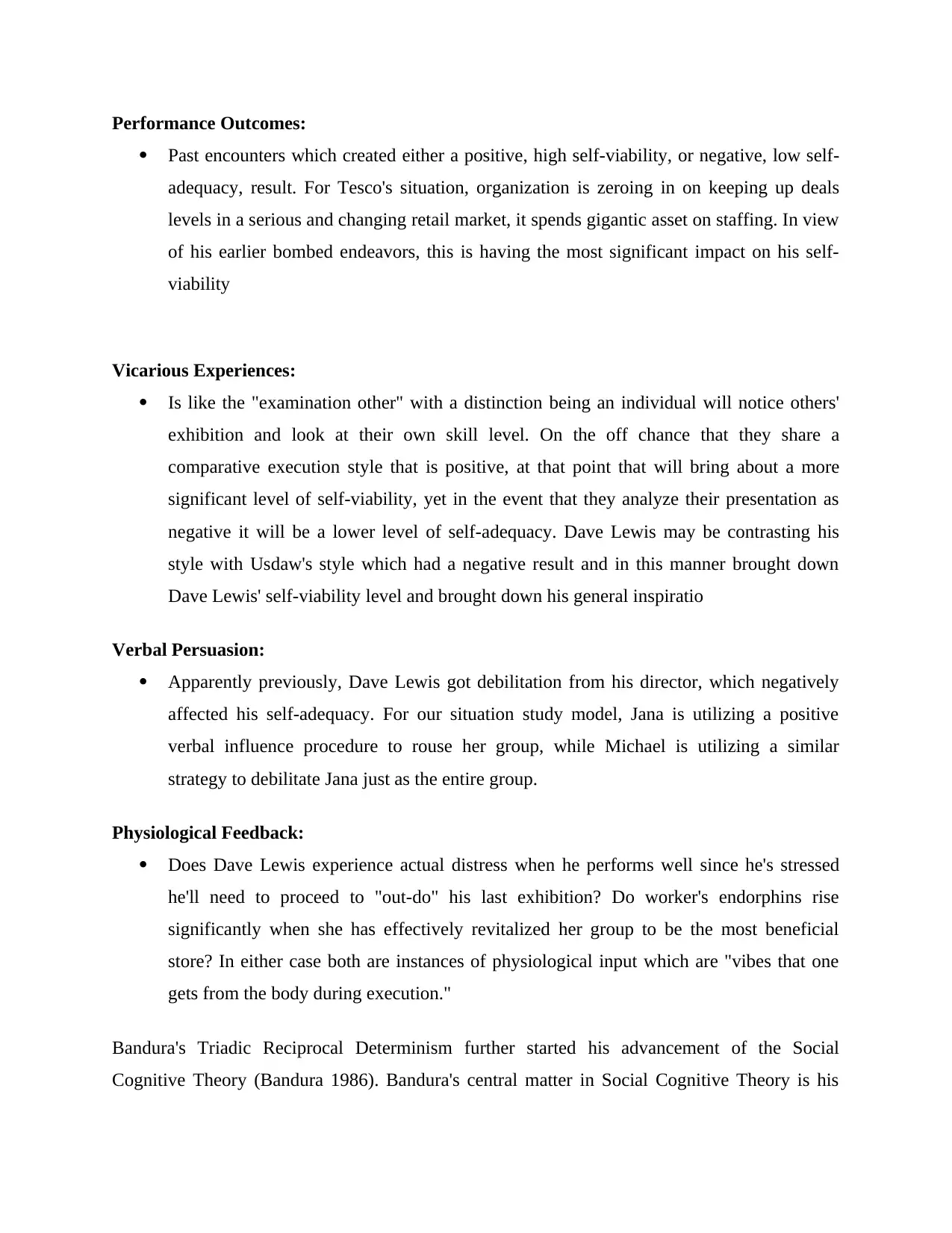
Performance Outcomes:
Past encounters which created either a positive, high self-viability, or negative, low self-
adequacy, result. For Tesco's situation, organization is zeroing in on keeping up deals
levels in a serious and changing retail market, it spends gigantic asset on staffing. In view
of his earlier bombed endeavors, this is having the most significant impact on his self-
viability
Vicarious Experiences:
Is like the "examination other" with a distinction being an individual will notice others'
exhibition and look at their own skill level. On the off chance that they share a
comparative execution style that is positive, at that point that will bring about a more
significant level of self-viability, yet in the event that they analyze their presentation as
negative it will be a lower level of self-adequacy. Dave Lewis may be contrasting his
style with Usdaw's style which had a negative result and in this manner brought down
Dave Lewis' self-viability level and brought down his general inspiratio
Verbal Persuasion:
Apparently previously, Dave Lewis got debilitation from his director, which negatively
affected his self-adequacy. For our situation study model, Jana is utilizing a positive
verbal influence procedure to rouse her group, while Michael is utilizing a similar
strategy to debilitate Jana just as the entire group.
Physiological Feedback:
Does Dave Lewis experience actual distress when he performs well since he's stressed
he'll need to proceed to "out-do" his last exhibition? Do worker's endorphins rise
significantly when she has effectively revitalized her group to be the most beneficial
store? In either case both are instances of physiological input which are "vibes that one
gets from the body during execution."
Bandura's Triadic Reciprocal Determinism further started his advancement of the Social
Cognitive Theory (Bandura 1986). Bandura's central matter in Social Cognitive Theory is his
Past encounters which created either a positive, high self-viability, or negative, low self-
adequacy, result. For Tesco's situation, organization is zeroing in on keeping up deals
levels in a serious and changing retail market, it spends gigantic asset on staffing. In view
of his earlier bombed endeavors, this is having the most significant impact on his self-
viability
Vicarious Experiences:
Is like the "examination other" with a distinction being an individual will notice others'
exhibition and look at their own skill level. On the off chance that they share a
comparative execution style that is positive, at that point that will bring about a more
significant level of self-viability, yet in the event that they analyze their presentation as
negative it will be a lower level of self-adequacy. Dave Lewis may be contrasting his
style with Usdaw's style which had a negative result and in this manner brought down
Dave Lewis' self-viability level and brought down his general inspiratio
Verbal Persuasion:
Apparently previously, Dave Lewis got debilitation from his director, which negatively
affected his self-adequacy. For our situation study model, Jana is utilizing a positive
verbal influence procedure to rouse her group, while Michael is utilizing a similar
strategy to debilitate Jana just as the entire group.
Physiological Feedback:
Does Dave Lewis experience actual distress when he performs well since he's stressed
he'll need to proceed to "out-do" his last exhibition? Do worker's endorphins rise
significantly when she has effectively revitalized her group to be the most beneficial
store? In either case both are instances of physiological input which are "vibes that one
gets from the body during execution."
Bandura's Triadic Reciprocal Determinism further started his advancement of the Social
Cognitive Theory (Bandura 1986). Bandura's central matter in Social Cognitive Theory is his
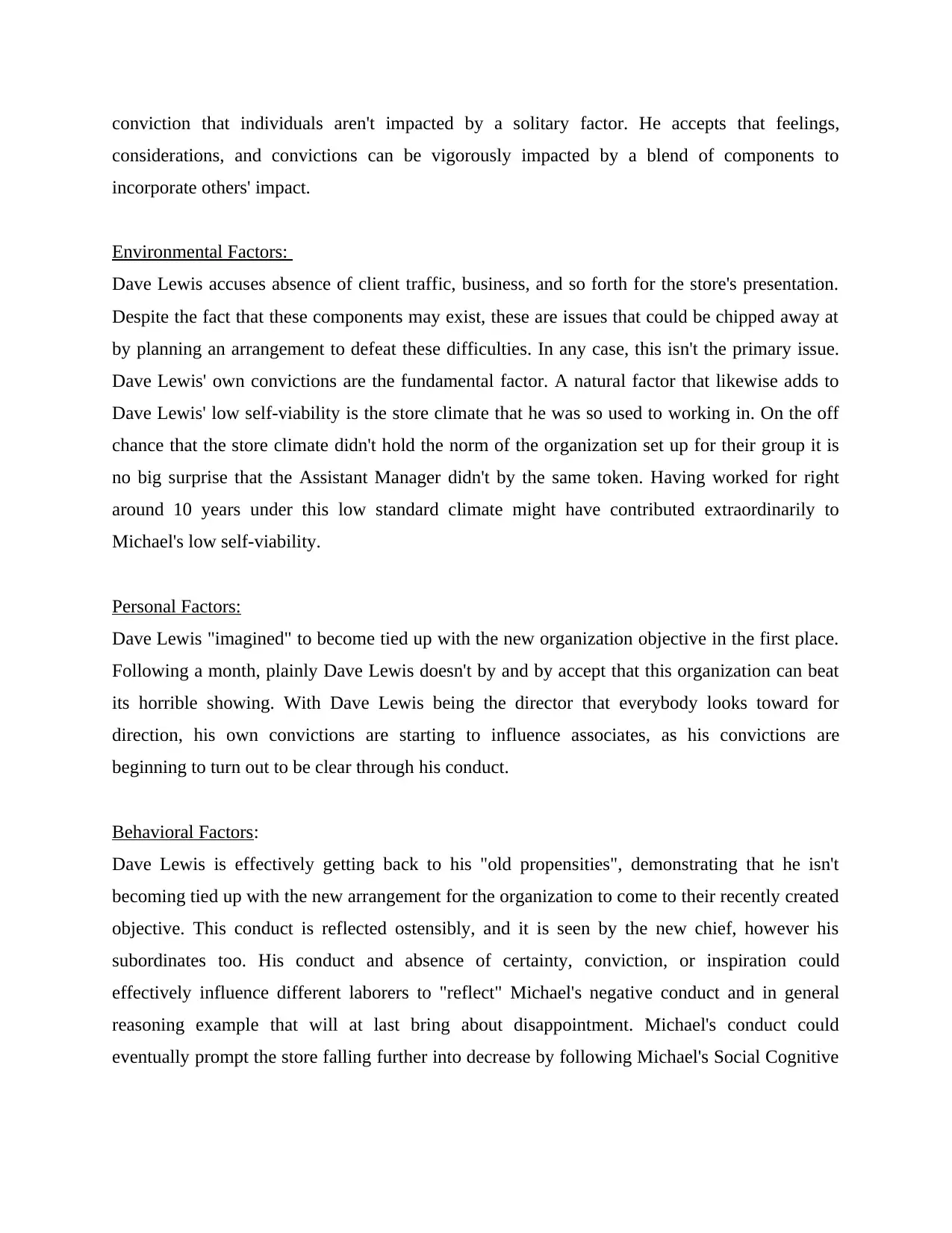
conviction that individuals aren't impacted by a solitary factor. He accepts that feelings,
considerations, and convictions can be vigorously impacted by a blend of components to
incorporate others' impact.
Environmental Factors:
Dave Lewis accuses absence of client traffic, business, and so forth for the store's presentation.
Despite the fact that these components may exist, these are issues that could be chipped away at
by planning an arrangement to defeat these difficulties. In any case, this isn't the primary issue.
Dave Lewis' own convictions are the fundamental factor. A natural factor that likewise adds to
Dave Lewis' low self-viability is the store climate that he was so used to working in. On the off
chance that the store climate didn't hold the norm of the organization set up for their group it is
no big surprise that the Assistant Manager didn't by the same token. Having worked for right
around 10 years under this low standard climate might have contributed extraordinarily to
Michael's low self-viability.
Personal Factors:
Dave Lewis "imagined" to become tied up with the new organization objective in the first place.
Following a month, plainly Dave Lewis doesn't by and by accept that this organization can beat
its horrible showing. With Dave Lewis being the director that everybody looks toward for
direction, his own convictions are starting to influence associates, as his convictions are
beginning to turn out to be clear through his conduct.
Behavioral Factors:
Dave Lewis is effectively getting back to his "old propensities", demonstrating that he isn't
becoming tied up with the new arrangement for the organization to come to their recently created
objective. This conduct is reflected ostensibly, and it is seen by the new chief, however his
subordinates too. His conduct and absence of certainty, conviction, or inspiration could
effectively influence different laborers to "reflect" Michael's negative conduct and in general
reasoning example that will at last bring about disappointment. Michael's conduct could
eventually prompt the store falling further into decrease by following Michael's Social Cognitive
considerations, and convictions can be vigorously impacted by a blend of components to
incorporate others' impact.
Environmental Factors:
Dave Lewis accuses absence of client traffic, business, and so forth for the store's presentation.
Despite the fact that these components may exist, these are issues that could be chipped away at
by planning an arrangement to defeat these difficulties. In any case, this isn't the primary issue.
Dave Lewis' own convictions are the fundamental factor. A natural factor that likewise adds to
Dave Lewis' low self-viability is the store climate that he was so used to working in. On the off
chance that the store climate didn't hold the norm of the organization set up for their group it is
no big surprise that the Assistant Manager didn't by the same token. Having worked for right
around 10 years under this low standard climate might have contributed extraordinarily to
Michael's low self-viability.
Personal Factors:
Dave Lewis "imagined" to become tied up with the new organization objective in the first place.
Following a month, plainly Dave Lewis doesn't by and by accept that this organization can beat
its horrible showing. With Dave Lewis being the director that everybody looks toward for
direction, his own convictions are starting to influence associates, as his convictions are
beginning to turn out to be clear through his conduct.
Behavioral Factors:
Dave Lewis is effectively getting back to his "old propensities", demonstrating that he isn't
becoming tied up with the new arrangement for the organization to come to their recently created
objective. This conduct is reflected ostensibly, and it is seen by the new chief, however his
subordinates too. His conduct and absence of certainty, conviction, or inspiration could
effectively influence different laborers to "reflect" Michael's negative conduct and in general
reasoning example that will at last bring about disappointment. Michael's conduct could
eventually prompt the store falling further into decrease by following Michael's Social Cognitive
⊘ This is a preview!⊘
Do you want full access?
Subscribe today to unlock all pages.

Trusted by 1+ million students worldwide

practices, as opposed to following the heading of the new, and exceptionally fruitful director who
100% accepts this store can make a turnaround and arrive at its objectives.
100% accepts this store can make a turnaround and arrive at its objectives.
Paraphrase This Document
Need a fresh take? Get an instant paraphrase of this document with our AI Paraphraser
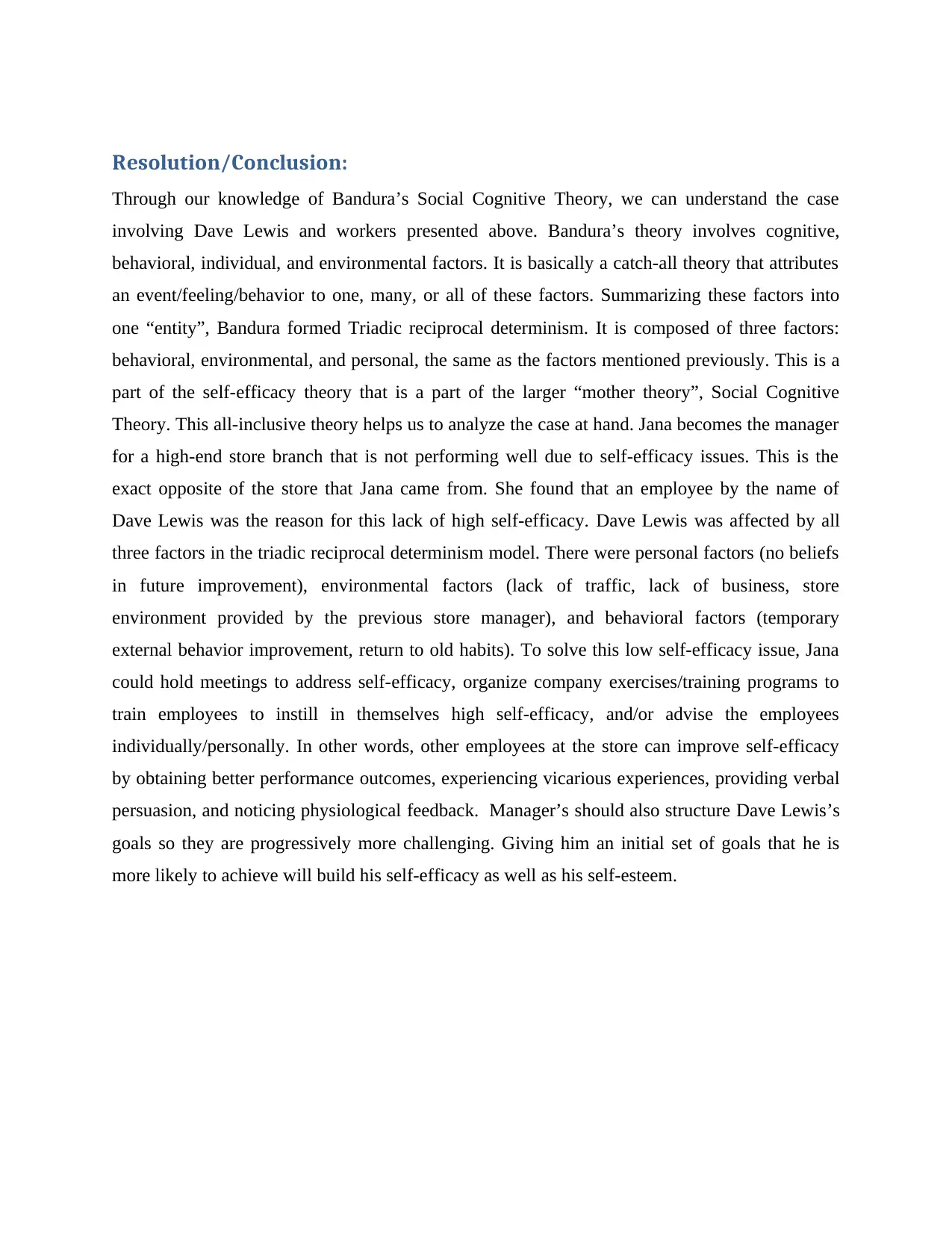
Resolution/Conclusion:
Through our knowledge of Bandura’s Social Cognitive Theory, we can understand the case
involving Dave Lewis and workers presented above. Bandura’s theory involves cognitive,
behavioral, individual, and environmental factors. It is basically a catch-all theory that attributes
an event/feeling/behavior to one, many, or all of these factors. Summarizing these factors into
one “entity”, Bandura formed Triadic reciprocal determinism. It is composed of three factors:
behavioral, environmental, and personal, the same as the factors mentioned previously. This is a
part of the self-efficacy theory that is a part of the larger “mother theory”, Social Cognitive
Theory. This all-inclusive theory helps us to analyze the case at hand. Jana becomes the manager
for a high-end store branch that is not performing well due to self-efficacy issues. This is the
exact opposite of the store that Jana came from. She found that an employee by the name of
Dave Lewis was the reason for this lack of high self-efficacy. Dave Lewis was affected by all
three factors in the triadic reciprocal determinism model. There were personal factors (no beliefs
in future improvement), environmental factors (lack of traffic, lack of business, store
environment provided by the previous store manager), and behavioral factors (temporary
external behavior improvement, return to old habits). To solve this low self-efficacy issue, Jana
could hold meetings to address self-efficacy, organize company exercises/training programs to
train employees to instill in themselves high self-efficacy, and/or advise the employees
individually/personally. In other words, other employees at the store can improve self-efficacy
by obtaining better performance outcomes, experiencing vicarious experiences, providing verbal
persuasion, and noticing physiological feedback. Manager’s should also structure Dave Lewis’s
goals so they are progressively more challenging. Giving him an initial set of goals that he is
more likely to achieve will build his self-efficacy as well as his self-esteem.
Through our knowledge of Bandura’s Social Cognitive Theory, we can understand the case
involving Dave Lewis and workers presented above. Bandura’s theory involves cognitive,
behavioral, individual, and environmental factors. It is basically a catch-all theory that attributes
an event/feeling/behavior to one, many, or all of these factors. Summarizing these factors into
one “entity”, Bandura formed Triadic reciprocal determinism. It is composed of three factors:
behavioral, environmental, and personal, the same as the factors mentioned previously. This is a
part of the self-efficacy theory that is a part of the larger “mother theory”, Social Cognitive
Theory. This all-inclusive theory helps us to analyze the case at hand. Jana becomes the manager
for a high-end store branch that is not performing well due to self-efficacy issues. This is the
exact opposite of the store that Jana came from. She found that an employee by the name of
Dave Lewis was the reason for this lack of high self-efficacy. Dave Lewis was affected by all
three factors in the triadic reciprocal determinism model. There were personal factors (no beliefs
in future improvement), environmental factors (lack of traffic, lack of business, store
environment provided by the previous store manager), and behavioral factors (temporary
external behavior improvement, return to old habits). To solve this low self-efficacy issue, Jana
could hold meetings to address self-efficacy, organize company exercises/training programs to
train employees to instill in themselves high self-efficacy, and/or advise the employees
individually/personally. In other words, other employees at the store can improve self-efficacy
by obtaining better performance outcomes, experiencing vicarious experiences, providing verbal
persuasion, and noticing physiological feedback. Manager’s should also structure Dave Lewis’s
goals so they are progressively more challenging. Giving him an initial set of goals that he is
more likely to achieve will build his self-efficacy as well as his self-esteem.
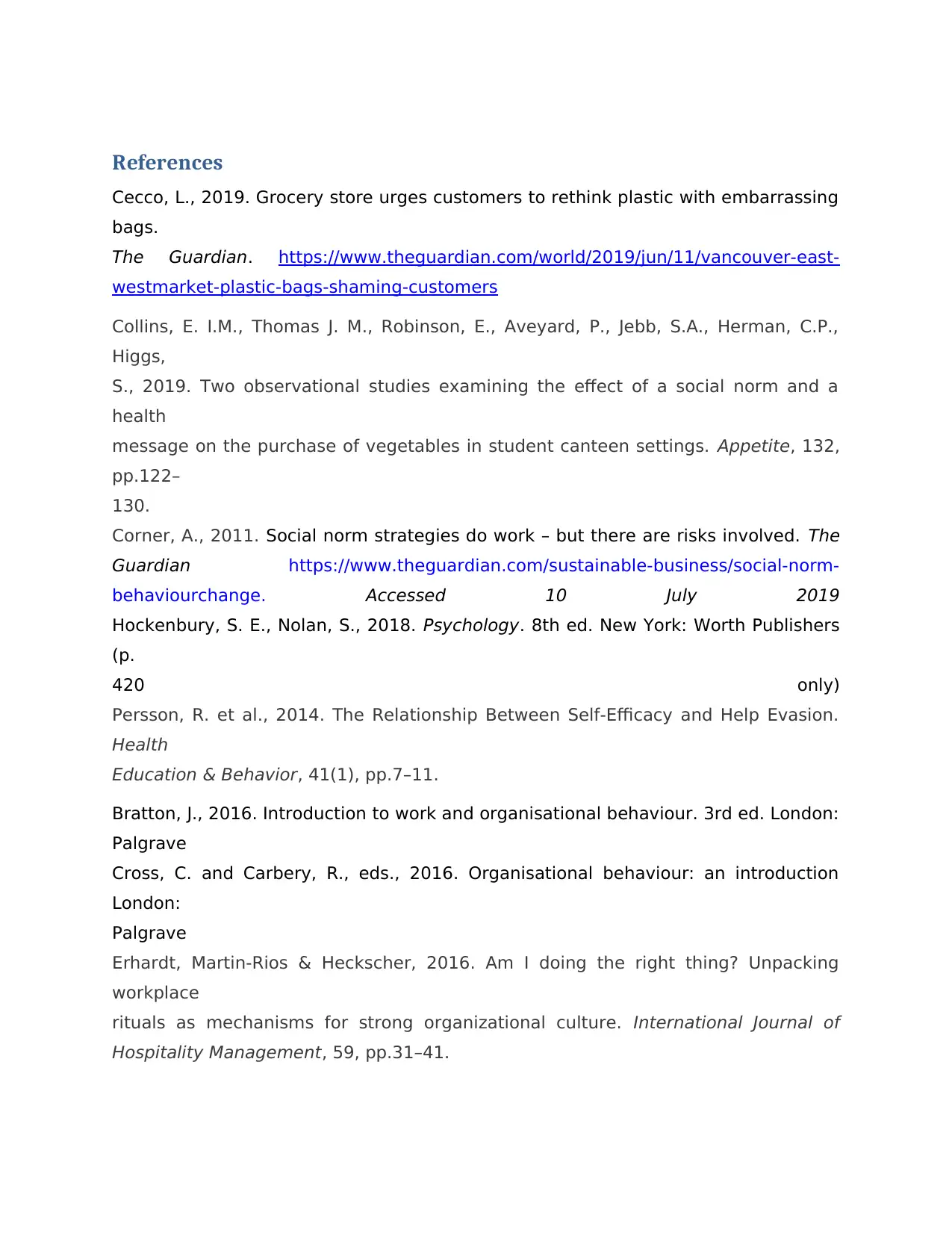
References
Cecco, L., 2019. Grocery store urges customers to rethink plastic with embarrassing
bags.
The Guardian. https://www.theguardian.com/world/2019/jun/11/vancouver-east-
westmarket-plastic-bags-shaming-customers
Collins, E. I.M., Thomas J. M., Robinson, E., Aveyard, P., Jebb, S.A., Herman, C.P.,
Higgs,
S., 2019. Two observational studies examining the effect of a social norm and a
health
message on the purchase of vegetables in student canteen settings. Appetite, 132,
pp.122–
130.
Corner, A., 2011. Social norm strategies do work – but there are risks involved. The
Guardian https://www.theguardian.com/sustainable-business/social-norm-
behaviourchange. Accessed 10 July 2019
Hockenbury, S. E., Nolan, S., 2018. Psychology. 8th ed. New York: Worth Publishers
(p.
420 only)
Persson, R. et al., 2014. The Relationship Between Self-Efficacy and Help Evasion.
Health
Education & Behavior, 41(1), pp.7–11.
Bratton, J., 2016. Introduction to work and organisational behaviour. 3rd ed. London:
Palgrave
Cross, C. and Carbery, R., eds., 2016. Organisational behaviour: an introduction
London:
Palgrave
Erhardt, Martin-Rios & Heckscher, 2016. Am I doing the right thing? Unpacking
workplace
rituals as mechanisms for strong organizational culture. International Journal of
Hospitality Management, 59, pp.31–41.
Cecco, L., 2019. Grocery store urges customers to rethink plastic with embarrassing
bags.
The Guardian. https://www.theguardian.com/world/2019/jun/11/vancouver-east-
westmarket-plastic-bags-shaming-customers
Collins, E. I.M., Thomas J. M., Robinson, E., Aveyard, P., Jebb, S.A., Herman, C.P.,
Higgs,
S., 2019. Two observational studies examining the effect of a social norm and a
health
message on the purchase of vegetables in student canteen settings. Appetite, 132,
pp.122–
130.
Corner, A., 2011. Social norm strategies do work – but there are risks involved. The
Guardian https://www.theguardian.com/sustainable-business/social-norm-
behaviourchange. Accessed 10 July 2019
Hockenbury, S. E., Nolan, S., 2018. Psychology. 8th ed. New York: Worth Publishers
(p.
420 only)
Persson, R. et al., 2014. The Relationship Between Self-Efficacy and Help Evasion.
Health
Education & Behavior, 41(1), pp.7–11.
Bratton, J., 2016. Introduction to work and organisational behaviour. 3rd ed. London:
Palgrave
Cross, C. and Carbery, R., eds., 2016. Organisational behaviour: an introduction
London:
Palgrave
Erhardt, Martin-Rios & Heckscher, 2016. Am I doing the right thing? Unpacking
workplace
rituals as mechanisms for strong organizational culture. International Journal of
Hospitality Management, 59, pp.31–41.
⊘ This is a preview!⊘
Do you want full access?
Subscribe today to unlock all pages.

Trusted by 1+ million students worldwide

Paraphrase This Document
Need a fresh take? Get an instant paraphrase of this document with our AI Paraphraser

1 out of 11
Your All-in-One AI-Powered Toolkit for Academic Success.
+13062052269
info@desklib.com
Available 24*7 on WhatsApp / Email
![[object Object]](/_next/static/media/star-bottom.7253800d.svg)
Unlock your academic potential
Copyright © 2020–2025 A2Z Services. All Rights Reserved. Developed and managed by ZUCOL.


